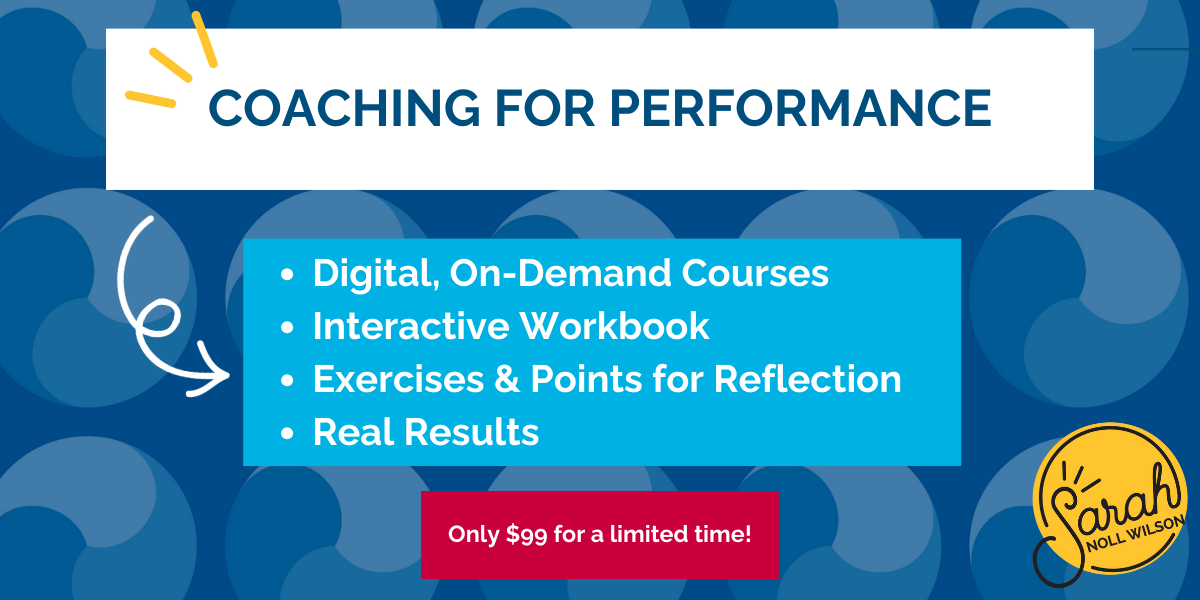
Visibility bias is a term to describes our preference for and deference to people who speak up first and talk the most/loudest. They are often perceived as being more confident, more competent, and better leaders.
This short discussion covers why that is problematic (tip: it excludes different types of thinkers) and provides strategies you can use to create spaces where everyone gets a chance to bring their best selves forward.
TRANSCRIPT
Hi everyone, it’s Sarah and Theresa for our monthly bimonthly. Let’s talk about periodic check-in of what we’re talking about and to invite you into this conversation. As always, our intention is not to say this is the one way or the right way, but we want to share with you what we’re wrestling with, what we’re seeing clients wrestle with, and to hear your thoughts. And so today we want to talk about this idea of visibility bias and how pervasive it is, particularly in Western American company culture, corporate culture. And for those of you who may be unfamiliar with the term visibility bias, I promise you’re not unfamiliar with what it looks like. And it is our preference and deference to people who speak up first, who talk the most, who talk the loudest as being perceived as more competent, as more confident, as more of a leadership. And so we wanted to just explore this and why that’s problematic, why it excludes different types of thinkers, and what are some strategies for how we can create spaces where everyone can get a chance to bring their best gift forward. And what better way to do it than somebody who’s really comfortable speaking quickly and fastly, not always like effectively. And Theresa, who would lovingly say her brain has an on-ramp. So, so Theresa, where
Speaker 2:
Do we start? I would like to start with acknowledging for anyone out there who’s thinking, I’ve seen this play out and I’ve been on the losing end of it. I’ve been on the losing side. It is very common for us to hear people say, I guess I can’t be a leader because I need to think about things. I want to toss it around in my idea in my brain a little bit. I want to filter what I say. I want to be a little less reactive and give it a minute to be a little more thoughtful. Not a week goes by, we don’t hear someone and pss often someone rate select out because they don’t think they will be that they know they’re not being currently seen or they think they will have to fundamentally change who they are and the way they speak up and speak out to suit someone else’s artificial timeframe, but that they would have to fundamentally change to exhibit leadership or be a leader, which is a made up construct or confine that we put on humans. So that’s my starting point. Hello. If you are a person with more than one filter, someone who needs to pinging pong it back and forth, you are seen and the world needs you and maybe you know that, but the people around you don’t that, right? The people I sort of validate that
Speaker 1:
Promoted it often are the people that would go, you’re really great. You create such an interesting space for Speaker voices. Now, does that mean if you’re more introverted or a slower thinker, do you naturally do that? Not necessarily, but largely the people we are seeing in these situations where they go, well, I don’t have executive presence, which is
Speaker 2:
Essentially, I don’t speak up first or loudest or lead out front.
Speaker 1:
And the thing that I’ve been reflecting on is one of the things we hear as development opportunities that people are told they need to work on is speaking up faster, speaking up more confidently, leading out front. And what’s interesting, or an executive team will say, we need you to help this person find their voice. But we’ve never, I think I can say this, we’ve never had a person in authority say, how do I make sure more voices are heard? What do I do to set them up for success? How do I adjust and approach things differently so that more people can be heard? It’s just more like I need them to be like me. I want them to speak up. And again, that’s really problematic because sometimes the problem isn’t that somebody’s not speaking up, it’s that the culture is created that we are only valuing the voices that speak up first and fast.
Speaker 2:
And I love the reframe of pushing ourselves to think, how do I create spaces where all voices can heard be heard? How can I create spaces where people have the think time they need? And that I don’t fall into the trap of, oh no, we’ve only got 15 seconds. I mean, we here give people think time. And I think people imagine it’s like, we’ll come back in three weeks. It can be five minutes. It doesn’t have to be that long. I think people, when they don’t value it, they overinflate the commitment or the time it would take to really pull this off. And I think some of us, what I can’t help but wonder, it feels like Americans, and I know more than Americans are watching this. So I’d be curious how this plays in your culture, right? Because thinking of this through an American lens of the individual, the general, the cowboy, the person, the voice, which isn’t how the best work gets done ever, this is making me laugh given how many people think about the Roman Empire on a daily basis, this statistic just came out, but glorifying Caesar, right? Glorifying the one person. When the best things involve teams involve the pushback. I’m thinking about, I don’t know, we could have an Abe Lincoln team of rivals moment where people come together with diverse ideas and processes and perspectives, and that is how the work gets better. And is that instantaneous? No, but it also could only take two hours. We have to let go of the facade that it would just take way too long. So we’ll only do it the way the loudest voice in the room said it, and that’s what we’re doing and goodbye. And you didn’t speak up. So the door is closed forever and she’s not a next level potential person or a top talent, America’s next top boss. I don’t know what it is, but
Speaker 1:
What comes up for you as I give some hammy pushback to that question? Yeah, no, I, and I think when we’re talking about American culture, we are talking pretty explicitly about white American culture of the cowboy, of the general of the right. Not only that high sense of urgency, but the voice. But that point of overestimating how long it actually takes to give some thinking time. Just yesterday in a session because, and I’ve, we’ve been talking about this, I’ve been pushing against my bias towards it. I’ve been trying to create more structures in our learning sessions, and probably there’s, well, not probably, there’s definitely an opportunity just even in our working relationship to be even more thoughtful about that. But I gave this group five minutes and I said, turn off your camera. I’m setting the timer for five minutes. You’re going to think about questions only for this problem and the quality across the board. Many people mentioned it, but one leader, one person in particular said, I just want to say how much I appreciated having just a couple of minutes to organize my thoughts to think really deeply about it. And I appreciated that it was only five minutes, but it was enough for me to be able to show up more effectively. So things like, so let’s talk strategies. One of the things that you and I have talked about this, but sometimes you see it in a different way and it’s like, oh, okay, now I know what it can look like. I saw this video on Facebook that somebody had shared, it was a math teacher for junior high kids.
And what she found was that anytime she would put a problem on the board and ask people if they have a thought about how they might start to solve it, as soon as a hand or two raised, the rest of the class essentially stopped thinking about it because they go, well, they’ve already got it figured out so I don’t need to wrestle with it. Which was missing out on the opportunity to hear different voices, different thinkers, but also to give the students an opportunity to continue chewing on the problem. So what she does instead now is she asks people or ask the students once she puts it up on the board to just subtly put a thumbs up once they have an idea
And she gives them time to really think about it. And then she calls on somebody who raised or who put up their thumb so they don’t see that other people have it figured out. They’re building that critical thinking. And so even things like in our sessions we’ve done, we have a question for you, take a minute just to reflect on it, jot down some ideas, and now let’s hear from a few of you has made a significant impact and hearing from more voices than just the person who has the fastest brain and is the most comfortable speaking up.
Speaker 2:
Yeah, I love everything about that strategy and it is highly transferable to adults. And something that’s hitting me about it is every company we encounter says they want that deep bench. I know you and I are becoming increasingly passionate about the folks on the bench. They all say they want it. And then the behavior is rewarding only the quick hands.
And a strategy like you described is one great way to build that bench that everyone is minds on the problem. Everyone is bringing different perspectives, everyone’s having a chance. In the math example, it was to get it right, but a chance to think about it with their best thinking. Something else that was coming up for me, another strategy. When we think about learning a huge barrier to anyone’s thinking pss, but especially folks who are particularly thoughtful or want to take a minute to kind of get their legs under them when we’re scheduled back to back when one meeting stops and one ends, particularly in our virtual and hybrid, it’s called residual attention. And everyone experiences this, that part of your brain is still working on the stuff from the last meeting, and now you’ve instantly tried to shift gears to the new meeting and you only have so much attention. And then when you keep, it’s like sticky notes or little place markers. I’m almost picturing cribbage board, but you move your little pegs, you have finite attention, and when you don’t give a chance to switch gears, it’s still back where you don’t want it to be.
So what I would love to see folks do more often, especially if you know you’ve been back to back, and even if you haven’t have a soft opening for the first five minutes, welcome. Here’s our agenda. Let’s warm up our thinking about this. This is when we really want to talk about five minutes for folks to pause. Maybe I’ve got 30 seconds worth of notes I need to take from the last meeting to free up some of my attention span, my focus ability. And then when we’re ready to jump in, we’re ready to just jump in. It takes as little as five minutes,
Speaker 1:
And I think the results people will see will be really big. And we also know that some folks get permission to spitball and some folks have to get it very close to the first time it comes out of their mouth or it’ll count against them. And that’s a whole other thing we could talk about. But in the spirit of giving everyone some time to frame up their thinking, I think benefits lots of humans helps push against our bias, helps open our perspectives.
And again, it doesn’t have to take that long, and I’m really glad that you mentioned that. The reality is is that some people can be imperfect, some people can meander, and depending on your identity, it could be your age, whether you’re younger or you’re much older, your gender, whether you’re the only woman in the room with a group of men, your racial identity, your sexual orientation. There’s a whole number of factors that add barriers to how you can show up authentically and and just being mindful of that. So here’s our invitation. Oh, the last thing. The other thing I know that this is something I I’ve learned about from working with you so closely is, and not everything should be a one and done conversation. Not everything needs to be solved in that hour conversation because there are so many times when you’ll send me a text later at night and you’re like, I was still chewing on this.
And it’s like, oh yeah. And I feel like more often than not, I’m like, yeah, damn, that’s a really good idea. So how do we also create space for people who are going to be thinking about it? And also, let me be really honest. Sometimes my first ideas aren’t the best ideas, but I’m like, yep, I got ’em. I set it out and then I’ve moved on to the next thing. But even when I give myself time to percolate on it, to gestate on it, to think about it in different situations, my thinking will deepen as well. And so how do you create opportunities to say what else has come up for folks? We had that really big conversation last week. What else has become clearer for you? What connections have you made? And just creating the space for that. So we would love to hear what works for you. I want
Speaker 2:
To share one more thing.
Speaker 1:
Yeah, please. Yeah.
Speaker 2:
Spirit of when you said that, it made me think and how do teams get clear? And teams could be two people, it could be 15 people, whatever. And how do we get clear about the issues? We’re fine to have those quick resolutions and about the issues that we want to devote more time to because as you said that I’m like, also, there are times when that feels close enough to write that let’s just try it and see how it goes, or it’s close enough to write and the constraints we have that it might not be worth investing any more time to figure it out versus things that we’re like, it’s all minds on this problem. So I think sometimes for folks we work with or listen, they want to just sort it into, this is a good idea, this is a bad idea for some of these strategies. And there are probably times it’s a great idea and probably times it’s unnecessary. So cue the context, right?
Speaker 1:
Yes. There’s always context. There’s always, yeah, that’s such a great point. And I feel like more often than not when we’ve been intentional about giving that space and we’ve been intentional about talking about why we’re giving that space, we always hear from people afterwards. I’m really glad. Thanks for saying that. Sometimes I feel like I’m not seen as strong of a leader because I think about things a little bit differently or longer than my peers. And again, the best ideas aren’t always the ones who are said first. And so how do we create a space where all brains and voices can be heard? So we want to hear from you. What have you done or seen others do that have been effective at creating a more inclusive environment for people sharing or just how does this resonate for you? So we would love to hear from you. You can always send us a message at hello@sarahnollwilson.com. Otherwise, yeah, that’s it.
Speaker 2:
Take some time to think about it. You can take some time
Speaker 1:
To think about. Yeah, there you go.
Speaker 2:
We’ll be ready to hear it whenever you’re ready to share it.
Speaker 1:
I love it. All right, thanks everyone.




